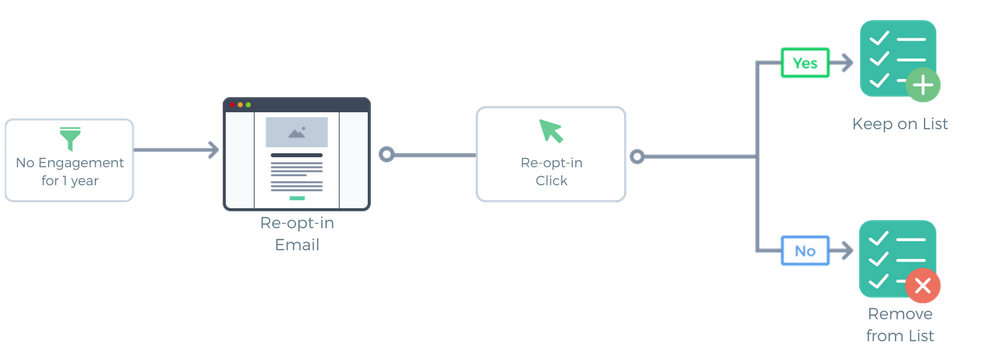

Year after year email marketing continues to prove its value with a strong continued ROI. But like any other form of marketing, email must be done right to see a positive return. If your email campaigns have resulted in lackluster performance, it might be because you are making some of the common email marketing mistakes.
Not sure how to avoid them?
Don’t worry, we’ve got your back. We put together a list of the 10 most common email marketing mistakes that you should avoid for better email marketing performance.
10 Common Email Marketing Mistakes to Avoid
1. Using an Old List
Emailing an old list can occur because of a technical glitch during a migration to a new email platform. However, disorganization can also be the culprit!
You might have gotten really motivated to collect contacts, but then got busy managing other aspects of your business and neglected your list for a couple of months (or even a year!).
You should never email an old version of your email list — doing so can cause emails to be sent to people who have since left your business or even unsubscribed (though hopefully, your email database reflects this correctly).
In addition to potential legal issues with the GDPR, sending to old contacts will damage your sender reputation when these disinterested recipients inevitably mark your communications as spam. It can also affect your deliverability stats when emails that are sent to old invalid addresses bounce.
That is why it’s so essential to follow deliverability best practices and avoid sending emails to old contacts.
2. Keeping Contacts that Aren’t Engaged
Many business owners and marketers pride themselves on their large email lists. But if your email list is artificially inflated with inactive recipients, it’s time to clean house. Weed out any contacts who haven’t been reading your emails or shown an interest in your business.
Segment out subscribers who have failed to open your emails for the past few months or a year and ask them to opt-in to communications again before keeping them on your email list. Depending on the nature of your business, you may also want to include subscribers who have not purchased in a while to determine if they’re still interested in what you have to offer.
A less aggressive approach would be to strategically test different marketing tactics on them to try to improve engagement before cutting them loose. You can email new types of content or change the frequency and timing of your emails to see if that improves their response rates.
Regardless of the approach, pruning your email list of dead weight will make it easier to focus your efforts on your most valuable subscribers!
3. Sending Mass Emails
Emailing the same content to your entire contact list is one of the biggest email marketing mistakes you can make — and it’s exceedingly common. You should always try to make your content as targeted as possible, so this strategy is not going achieve that.
Segmentation is key when it comes to email marketing because it allows you to organize smaller, more focused groups to market to more effectively. Tailor your communications based on a segment’s purchase patterns, engagement history, preferences, demographics, or some other unifying characteristic.
Even if you have a huge list (e.g. monthly newsletter), try to use personalization when possible to vary the content or make it more relevant and engaging to the reader. There are plenty of newsletter examples out there that use personalization to deliver a more targeted message to big audience.
4. Forgetting to Set Preview Text
You spent a lot of time crafting and testing the perfect email subject line – great! But you forgot altogether to set the email preheaher (a.k.a. email preview text) – oops!
As the name would imply, preview text gives recipients a sense of what your email is about before clicking on it.
Ideally, your preview text should be a quick one-liner summarizing your email in a way that entices recipients to prioritize your email over others in their inboxes. However, setting something is way better than not including anything at all. If you don’t choose to include anything, it will automatically propagate with something from the email. At best, this random text might just be uninspiring, and at worst, it may be completely off-putting (think “click here to unsubscribe” or some jumbled HTML that could be confusing).
5. Sending Emails without a Goal
Always have a reason for emailing subscribers.
You should never just send an email for the sake of sending one (like if your boss expects you to send weekly emails and you really can’t think of anything to say this week). Bothering your contacts for no reason can decrease engagement and increase unsubscribe rates, which will hurt your overall email deliverability in addition to your reputation with customers.
Before sending any email campaign, be sure to ask yourself, “what is the main goal of this campaign?” Whether it’s promoting your content and company news in a newsletter, driving traffic to your store for a promotion, or rewarding loyal customers with a special discount, you should always have a clear purpose for sending an email campaign. If there isn’t a clear answer, you should probably go back to the drawing boards.
6. Not Optimizing for Mobile
Using a responsive email template is a great way to ensure that readers on mobile devices will be able to easily read and interact with your emails. Since most people check their email from smartphones and tablets these days, this is more important now than ever before.
Send a test email whenever you make changes to your template, then evaluate the email on as many device types and operating systems as possible before launching a full email campaign. You can also use an email testing software like Litmus to accomplish this.
Testing your email campaigns will help you avoid alienating users on certain types of devices if interface differences cause your email to fall short of expectations somewhere.
7. Sending Emails Too Often
A lot of companies commit the cardinal sin of emailing subscribers too frequently. Spamming people with emails is a surefire way to turn them off and hurt future chances of reaching them with your best content and promotional offers.
That’s why you have to learn how to send bulk email without spamming. Once subscribers decide to tune you out, it’s very difficult to win back their attention.
Respect customers’ time and make sure you’re only sending quality offers and content in a way that isn’t frustrating or disruptive to their normal inbox experience.
8. Not Being Consistent
On the other end of the spectrum are the businesses that are too inconsistent with their emails.
Inconsistency is just as big of an email marketing mistake as sending emails too frequently. Failing to set and stick to a schedule can result in your contacts getting frustrated when emails are unpredictable or forgetting that they subscribed altogether.
Your goal should be to keep your brand relevant by emailing subscribers regularly. If you only email subscribers here and there when you have a moment to throw something together, people won’t know what to expect and they will forget about your business. This brand distance leads people to unsubscribe and mark emails as spam even if they were once genuinely interested in receiving your messages!
9. Making it Hard to Unsubscribe
Every email you have should include an unsubscribe link that’s readily identifiable and easy to find. When someone is ready to leave, don’t make it hard for them to go by burying or obfuscating your unsubscribe link.
The unsubscribe link should then take people to a page that’s straight-forward and allows them to remove themselves from your list without having to jump through hoops. Nothing makes people angrier than having to invest a lot of effort into keeping your emails out of their inboxes.
Remember, marking an email as spam takes about 2-seconds. So, if unsubscribing takes much more time than that, many recipients won’t bother to put in the effort.
10. Not Testing
You should always be testing new ideas in your email campaigns.
Although many marketers like to go with their “gut” on what they think is right, sending emails without collecting and analyzing data is a big mistake that can hurt performance in the long-run.
Email marketing software like Sendinblue allows you to easily monitor campaign performance, so there’s no excuse not to. You should be sure to test your subject line, preview text, call-to-action (CTA), content, and promotional offers and then look at the performance data to make the right strategic decisions.
If you want more content like this, subscribe to our newsletter or follow us on Twitter!
 Deutsch
Deutsch

























Comments
Thankful to you for writing this article and making me improve all my email mistake. It’s this kind of article that I was searching for to improve my email marketing strategy. Thanks a lot for such a great article!
Thanks for filling up the things we need to adjust or improve, your blog is amazing as you pin every necessary detail. I hope I had read this way early before but it’s fine since I learned from my own experience. Thanks again!